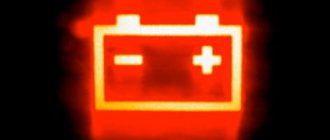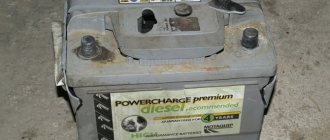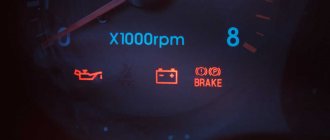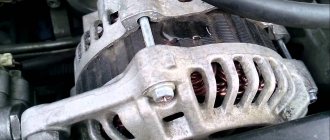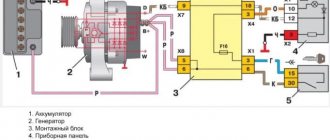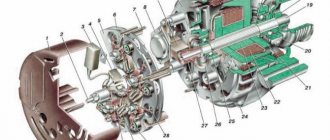If you discover that the generator on your VAZ 2110 does not charge, you should immediately look for the cause of the malfunction, because the supply of all electrical equipment with current, as well as charging the battery, is at risk.
Generator
As you know, with a working generator, the battery does not require charging for many months and years, while maintaining at least 60% charge. That is, a battery with a capacity of 55 Ah, which is usually equipped with dozens, is replenished with current due to the operation of a working generator.
Basic problems
If the generator begins to act up, then the main causes of the malfunction should be sought either in the on-board network, or these are problems with the generator itself. If the generator gives a charge, but not enough, then perhaps it has been “loaded” too much by installing many other gadgets in addition to the standard electrical equipment, and it is already working at the limit of its capabilities.
Our motorists really love tuning the VAZ 2110, adding, for example, speaker power, enhancing the light, etc. In such cases, some people change the battery, for example, installing it with a capacity of 70 Ah, instead of the usual VAZ one with 55 Ah.
But although this may help at first, over time such a battery will run out even faster, since a standard generator will not be able to provide it with a full charge; it does not have enough power for this.
The reasons for battery discharge are described in detail in the following material:
The main reasons why the generator does not charge the battery
To identify problems, it is necessary to diagnose both the entire on-board network, which may draw too much energy, and the generator itself. If you have tuned your car, equipping it with additional electrical equipment, you will need to check its energy consumption level and serviceability.
Very often, to compensate for the current consumption of third-party devices, car enthusiasts install high-capacity batteries. However, the generator power remains at the same level, so this measure has no effect.
troubleshooting
To accurately determine the source of the problem with the generator, you need to perform a basic check. If you do not have “additional” energy consumers, you can immediately look for generator faults; if there are any, turn them all off for a while. Moreover, do not turn it off, but simply disconnect it from the car.
Test plan:
- Measure the current output on a cold car, when it is not running and all its life support systems are turned off. It will be ideal if there is no return at all. But this happens extremely rarely. On almost every VAZ 2110, somewhere due to insufficient contact, local short circuit, etc. There is still a small return. But - just a small one, and not one in which the battery can run out during a night of parking;
- If everything is normal, there are no current leaks, or they are negligible, the battery is not discharged, reconnect all those devices that you (no matter, independently or with the help of hired specialists) installed on your car on your own initiative. Repeat the same check. If it turns out that current is actively leaking, it means that the reason is not in the battery and is not related to the generator; it is the device not provided for by the designers of the VAZ 2110 that is to blame;
- But if even then no kickback is detected, we proceed to a thorough examination of the generator. And here there are many possible malfunctions: • there is not enough contact between the brushes and the rotor rings; • there is a break in the excitation winding; • an interturn short circuit is possible directly in the field winding coil. At the same time, the generator heats up and hums; • the field winding may short-circuit to the rotor housing; • breaks can also occur in the stator phase winding; • the stator can short-circuit to the housing; • possible short circuit of the “plus” to the housing; • diodes in the rectifier unit can be pierced; • mechanical failures also occupy a significant place on this list.
It is possible to repair or replace the generator yourself if you have the proper desire and knowledge of the nuances of the procedure. Details:
Now let's look at all of the above generator malfunctions in more detail.
What is on the VAZ 2110
For VAZ 2110 cars, the installation of two types of generators is provided, depending on the installed engine.
- For carburetor models, a generator with number 9402.3701 is installed.
- If the engine is injection, then the catalog number of the generator used will be 3202-3771. It has a serpentine belt.
Regardless of the type of installed engine and generator, respectively, problems with the devices are the same, therefore the inspection and repair procedure is identical in both cases.
Winding break
If the excitation winding is broken, then there is no charging of the battery. To determine this, it is often enough to place your hand on the generator. When it breaks, it heats up. For an accurate check, you need to disconnect the end of the excitation winding from the brush, connect the battery wires to it, and connect the battery wires to terminal Ш of the generator (via a voltmeter or a light bulb).
If there is a break, the voltmeter needle will not deflect and the light bulb will not light up. To find which of the coils prevents the generator from working, connect the wires from the battery to each individually. Finally, check the soldering and coil terminals. If the break is internal, the coil needs to be replaced; for external ones, soldering helps.
Car diagnostics to identify problems with battery charging
First, we need to check the correct operation of the battery charge indicator located on the dashboard. It is quite possible that it is simply showing incorrect data, confusing you, and no serious repairs will be required.
The next important step is to check the functionality of the fuse. It is better to immediately replace it with a known-good device and try to start the engine. If the charge indicator goes off immediately, the problem has been detected and successfully resolved.
Battery still won't charge? Let's try to detect a current leak, if any. For this purpose, we check the car when it is cold, when all its systems are completely turned off. A small voltage release in such a situation is considered normal, since in almost any machine a weak contact can be detected in some parts of the circuit and a local short circuit can be identified. If the leak is so large that the generator is not able to charge the battery, the alarm should be sounded.
If there is no strong current output, we carry out exactly the same test, but with the connection of the equipment installed during the tuning process. In this case, this will be the cause of the leak. The easiest way to solve the problem is to remove all third-party devices.
Design features
So, before dealing with malfunctions, there is a principle of operation of the device. We take VAZ 2110, 21099 and 2109 as a basis. First of all, you should understand that this device actually works only due to electromagnetic induction. However, we will not delve into the basics of elementary physics, but rather let’s figure out what the device consists of that generates alternating current for the electronics of VAZ 2109, 21099 and 2110 cars. In the case of these cars, a classic type of generator is used, which has the following design:
- Rotary part of the device.
- Stator.
- Device body.
- Voltage regulator.
- Generator brush assembly.
- Rectifier block.
In general, if we talk about the generator as a whole - this device has exceptional reliability and breaks down very rarely, the main reason for the malfunction of the device that generates current for VAZ 2109, 210999 and 2110 cars can be the following factors:
- The parts for the generator are either counterfeit or defective.
- Exceeding operating standards (very rare due to the fact that those same standards are very high and difficult to achieve).
- Corrosion as a result of foreign liquids entering the mechanism, for example, salt water, road reagents or dirt.
In addition to these very basic faults, which are associated with mechanical or electrical breakdowns in the electrical system of the VAZ 21099, 2109, 2110. The case can be either typical or completely original. However, before undertaking repairs or diagnostics, it makes sense to study the qualifying signs of a generator malfunction.
Generator VAZ 2110
Theory of the issue
While the car is moving, a dead battery receives a charge voltage of 13.6 to 14.2 V. For the correct and stable operation of all systems in the car, these voltages must be maintained until the engine starts and the crankshaft rotates. Together with the motor, torque is supplied to the generator through the drive belt. At this moment, an amount of energy is generated that will be sufficient for the stable functioning of all systems and to maintain a charge on the battery.
If the generator does not charge, then in most cases the reasons must be sought in the excitation circuits, as well as in the output voltage circuits from the generator to the battery. But this is not always the case. Sometimes problems are related to the generator itself.
When the driver turns the key in the lock, the relay in the ignition system also starts at the same time. “Plus” flows through the relay and fuse in the mounting block. Next, the voltage passes through the on-board network, reaching the battery charge lamp and charge sensors. It then passes through diodes, relays, elements in the mounting block and finally to the connector in the generator. There, electricity comes to the relay-regulator and, passing through brushes and slip rings, enters the exciting winding.
Dips when pressing the gas pedal during acceleration
Determined using computer diagnostics or the steps described below:
- The first thing you need to do is inspect the spark plugs. To do this you need to remove them. The presence of carbon deposits on the spark plugs, poor contact with the wires, or an excessively lean or rich mixture lead to spark plug malfunctions.
- High voltage wires can also cause engine malfunction, as can ignition coils.
- The throttle needs to be checked. If it is clogged, this causes the engine to respond untimely when pressing the gas pedal.
- It is necessary to check the condition of the air, fuel and oil filters. They tend to get clogged, which worsens dynamics, increases fuel consumption and causes pedal failure. They need to be changed constantly, you can do it yourself, they are inexpensive and easy to install.
- The presence of errors in the ECU leads to failures.
- Clogged injectors. If necessary, replace or repair injectors.
The wires, as well as the rubber bands on them, should not be damaged and should not spark when the engine is running. If damage is found, this indicates that the engine is shaking and jerking begins. This may occur due to the age of the car, worn-out or low-quality spare parts, poor contact with the spark plugs, or due to the temperature of the engine.
The resistance of the coils and the temperature change together, as a result of which a gasoline car begins to jerk during acceleration. In diesel cars, jerking cannot be associated with the coils, since they are not present.
see also
Comments 30
Change the generator! As practice showed me 3 months ago, REPAIRING A GENERATOR IS A ROTTEN BUSINESS! And besides, all this won’t last long! It’s easier to add a little and buy a new one! As I did)) it’s up to you, of course, see for yourself))
look at the diode bridge I also had it. good luck
ok thanks for the advice(
The other day I had the same problem, but since the gene was already done and redone, I decided not to worry and installed a new one and the problem was solved instantly =)
What are failures?
Failure when pressing the gas pedal lies in the improper reaction of the engine to this. Thus, when trying to accelerate, the engine does not gain the required speed.
This leads to a drop in speed. It manifests itself with gradual and sudden acceleration. Dips appear when you press the gas pedal in different ways:
- Short-term failures. There is no response to pressing for a couple of seconds.
- Lingering failures. The engine loses speed for 4 to 10 seconds, and it is possible that the car will stall.
- Jerks. Dips up to 1 or 2 seconds. The car seems to be “twitching”.
- A series of jerks. The engine either increases speed or slows down, although the pedal is in the same position.
- The car jerks. Consists of a series of protracted failures.
Generator malfunctions that should be given priority attention
That's all of the above methods for checking the condition of the VAZ 2112 generator, carried out for preventive purposes. Now let’s move on to a more detailed analysis of generator malfunctions and find out how to fix them.
Alternator belt tension
VAZ 2112 no generator charging
One of the most common types of malfunctions. Ideally, this belt on a VAZ 2112 should bend by only 10-15 mm, if we are talking about a force of 100 N.
- Open the hood of the car.
- We carefully inspect the belt, since the problem may be hidden not in tension, but in a broken belt.
- We press our finger on the middle of the branch, which is located between the crankshaft and the generator. As mentioned above, you can pull the belt branch with a hook so that the force is 100 N.
- The deflection is measured with a narrow metal ruler, which is placed on top of the crankshaft and generator pulleys.
- If during the inspection it becomes clear that the generator belt is loose and does not meet the standards, its tension is adjusted.
VAZ 2112 generator problems
- Adjusting the tension begins by loosening all the nuts located at the top and bottom of the generator.
- Take the key and use it to turn the crankshaft just two turns.
- After this, the belt tension is checked again. And if it is below normal, then the crankshaft turns a couple more revolutions.
When the generator does not provide charging current or provides it only slightly
This is also a common malfunction due to several reasons:
- General break in the circuit.
- Drive belt slipping.
- Stuck generator brushes.
- The rotor touches the stator poles.
- The excitation circuit has broken.
VAZ 2112 generator is heating up
When the generator provides current but the normal charge of the battery is not ensured, then in this case the following phenomena are observed:
- A turn short circuit or, again, an open circuit from the stator phases.
- The generator is in poor contact with the voltage regulator, or rather with its ground.
- The voltage regulator protection relay is triggered, which is caused by a short circuit in the generator circuit.
- Problem with brushes that freeze.
- If the generator brushes are stuck, dismantling the generator, followed by removing the brush assembly, will help solve the problem. The brush holder and brushes are cleaned of dirt and dust, and the force of the brush springs is checked.
- If the slip rings burn out, they need to be cleaned or sharpened, depending on the stage.
- If there is an open circuit, you need to find and eliminate it.
- If the rotor touches the stator poles, you need to check the operation of the bearings and their seating locations. Damaged parts will naturally need to be replaced.
- If the voltage regulator is faulty, it must be completely replaced - repair will not help.
- If there is poor contact between the generator and the regulator, the integrity of the wire that goes to ground and the reliability of the contacts are checked.
- If the voltage regulator protection relay is triggered due to a short circuit in the circuit, then you need to find the cause and eliminate the fault.
- If the brushes are worn out, you will have to replace them with new ones.
- If the slip rings become oily or dirty, you will need to wipe them with a cloth moistened with acetone.
- If the voltage regulator is faulty, you need to check it and, if necessary, replace it with a new one.
- If there is a turn short circuit or an open circuit in one of the phases of the winding, then you will need to disassemble the generator and check the condition of the winding. If the winding is faulty, it is completely replaced.
- When bearings wear out, they are replaced.
- When the bearing seat wears out, the generator cover is replaced.
- If there is an interturn short circuit in the stator winding, replace the stator.
No charging
Indicator
On carburetor and injection VAZ 2110, the lamp on the dashboard, indicating a malfunction in the battery charging circuit, is connected via a relay to the output of the generator.
If the lamp is constantly on and there are no problems with the battery, then the warning lamp relay and the generator-relay-dashboard wiring are checked. If the light does not light up when you turn on the ignition, then most likely it is the one that has failed.
If there is a simultaneous indication of a malfunction and the battery is undercharged, the cause must be sought in the generator and relay regulator, although it is possible that the drive belt may simply slip due to a loose fastening.
Voltage regulator
On a running car, disconnecting the negative battery from the battery when the generator is faulty will cause the engine to stop. Such a check cannot be carried out on an injector, only on “old” eight-valve engines. The relay regulator (“tablet”) ensures that the generator output voltage is maintained within the range of 13.2–14.7 volts.
The voltage at the battery terminals, with the engine running at different speeds, should not go beyond this range (a sag at the time of start-up is acceptable). Structurally, for engines with both a carburetor and an injector, the regulator is located in the generator; in case of defects, it is replaced entirely.
Diode bridge
Diode breakdown also leads to a lack of output current for charging; often such a defect occurs after a short circuit in the cigarette lighter socket, when connecting “left-handed” electronic car accessories, or after incorrectly connecting the polarity of the battery terminals.

